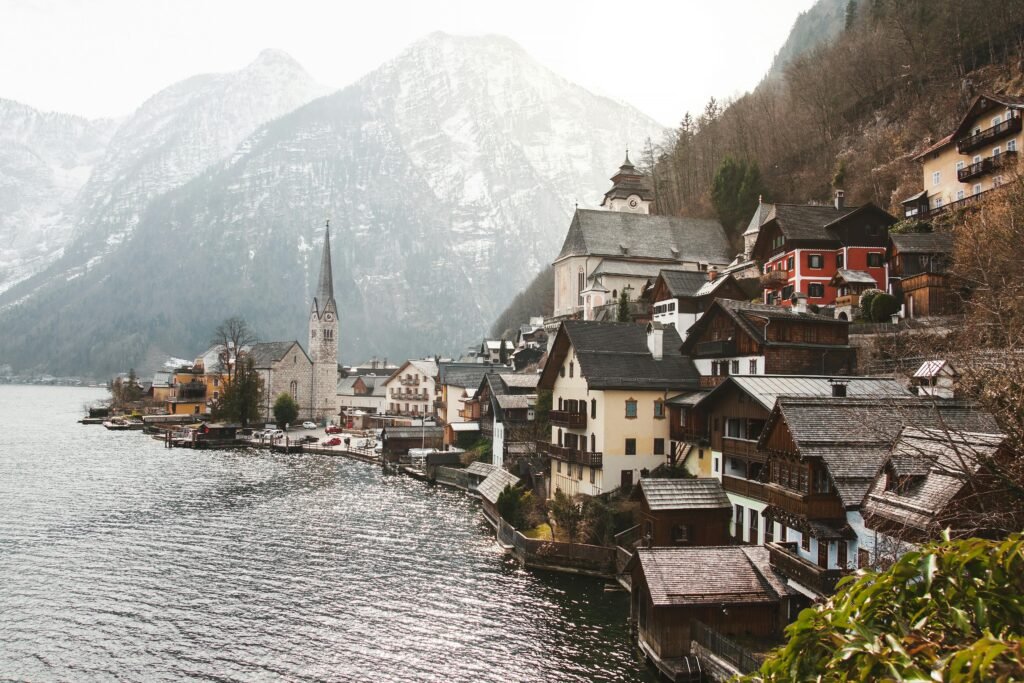Introduction to Hidden Gems
The world is brimming with travel destinations that remain under the radar, often referred to as hidden gems. These locations are characterized by their lesser-known status compared to popular tourist spots, which tend to attract large crowds and commercial enterprises. While iconic landmarks have their undeniable allure, hidden gems offer a unique charm that can lead to more enriching travel experiences.

One of the defining features of a hidden gem is its ability to offer visitors a genuine glimpse into local culture. Unlike heavily tourist-infested areas, these destinations allow travelers to engage authentically with residents and partake in traditions that might not be readily available at more famous locations. By visiting these sites, travelers can immerse themselves in the local way of life, enjoying customs, cuisine, and crafts that have been passed down through generations.
Choosing to explore hidden travel destinations also comes with practical benefits. Lesser-known places are often less crowded, allowing visitors to enjoy attractions at a leisurely pace without the stress of large crowds. This tranquility can significantly enhance the travel experience, making it more enjoyable and personal. Moreover, exploring these destinations often supports local economies that rely heavily on tourism. When traveling to lesser-known locations, individuals contribute directly to local businesses, artisans, and communities, helping to foster sustainable economic development.
In a world where travel experience has become increasingly homogenized, seeking hidden gems can reveal extraordinary places that hold unique stories and breathtaking landscapes. These locations embody the essence of adventure, encouraging travelers to venture beyond the well-trodden tourist paths and discover the vast array of experiences waiting to be uncovered. By prioritizing these hidden gems, travelers can create memories that resonate deeply, bridging connections with the places they visit and the people they meet.
Criteria for Choosing Hidden Destinations
Identifying hidden destinations requires a discerning approach, as various factors contribute to what makes a location genuinely concealed from the mainstream tourist trail. A primary criterion is accessibility, which refers to how easy or difficult it is to reach a destination. Often, hidden gems are situated in remote areas, requiring a level of effort that dissuades large crowds. Travelers seeking these locales may need to engage in extensive planning, utilizing alternative travel options that may not be well-known or frequently used.
Another essential aspect to consider is the local population size. Smaller towns or villages often maintain their charm and authenticity, as compared to large cities buzzing with tourists. These areas allow for more intimate interactions with local cultures and traditions, providing travelers with a genuine experience. The demographic composition plays a role here as well; regions with a stable and engaged local community are more likely to offer a welcoming atmosphere.
The existing tourism infrastructure also contributes to a destination being classified as hidden. Locations that lack extensive facilities dominated by mass tourism tend to preserve their essence better. The limited availability of familiar amenities may mean fewer visitors, yet such destinations often showcase unique attractions that reflect their cultural heritage. Visitors will discover local dining options, artisanal craft shops, and genuine experiences that larger tourist hubs may lack.
Lastly, the preservation of cultural heritage is vital in ensuring that a hidden destination remains authentic. Effective preservation efforts, such as maintaining historical sites and traditional practices, attract travelers seeking to engage with local customs. By evaluating these criteria—accessibility, local population size, tourism infrastructure, and cultural preservation—travelers can discover destinations that promise enriching and genuine experiences away from the crowded hotspots.
Destination #1: Socotra Island
Located in the Arabian Sea, approximately 240 kilometers south of the mainland of Yemen, Socotra Island is a unique hidden gem that remains largely untouched by mass tourism. This isolated island boasts an extraordinary level of biodiversity, with more than 30% of its plant species being endemic, meaning they can only be found here. The island is often referred to as the “Galápagos of the Indian Ocean” due to its rich flora and fauna, including the famous Dragon’s Blood Tree, known for its distinctive appearance and red sap.

Culturally, Socotra is home to various ethnic groups, primarily the Soqotri people, who have their own distinct language and traditions. The island’s relatively low population density has helped preserve its cultural heritage, allowing travelers to experience a way of life that has remained largely unchanged for centuries. The community’s connection to their environment is evident in their sustainable practices and respectful use of natural resources.
Unique attractions abound on Socotra Island. Visitors can explore stunning landscapes featuring pristine beaches, towering limestone mountains, and sprawling dunes. The island is a paradise for nature lovers and adventure seekers alike. Hiking opportunities range from challenging mountain treks to leisurely coastal walks, allowing travelers to immerse themselves in the breathtaking vistas. Snorkeling and diving are also highly recommended, as the surrounding waters are home to vibrant coral reefs and diverse marine life.
Despite its alluring characteristics, Socotra remains largely off the radar for many tourists. Accessibility can be a challenge, as flights to the island are limited and often dependent on regional security situations. However, those who are willing to embark on the journey to Socotra will discover a tranquil oasis, rich in natural beauty and cultural significance, providing an unparalleled travel experience that stands apart from well-trodden tourist paths.
Destination #2: Bled, Slovenia
Nestled in the heart of the Julian Alps, Bled is a picturesque destination that has remained largely under the radar for many travelers. Located about an hour’s drive from the capital city of Ljubljana, this enchanting region is distinguished by its stunning lake, which is adorned with a small island featuring a charming church. Lake Bled offers breathtaking views, and the surrounding mountains create a perfect backdrop for both relaxation and adventure.
One of Bled’s unique features is its castle, which sits atop a steep cliff overlooking the lake. Bled Castle is one of the oldest in Slovenia, dating back to the 11th century, and provides visitors with fascinating insights into the area’s history. Inside, you can explore a museum that showcases the region’s cultural heritage or enjoy a meal with a view at the castle’s restaurant. The local customs are equally captivating; for instance, traditional Pletna boats are often used for transporting visitors to the island, and you can even partake in the local tradition of ringing the church bell for good luck.

Given its combination of natural beauty, rich history, and inviting charm, Bled is an exceptional destination to experience before it becomes mainstream. Outdoor enthusiasts can enjoy hiking, cycling, and even paragliding, while those seeking tranquility can take leisurely strolls along the lake path. As Slovenia gains popularity in tourism, particularly among nature lovers, the once-quiet charm of Bled may soon be overshadowed. Thus, visiting this stunning locale now offers an opportunity to appreciate its unspoiled beauty and authentic local culture before it becomes widely known. Its serene atmosphere, combined with a rich array of activities, makes Bled a must-visit.
Destination #3: The Enigmatic Isle of Skye
Nestled off the northwest coast of Scotland, the Isle of Skye is a breathtaking hidden destination that captivates visitors with its rugged landscapes, dramatic cliffs, and rich history. Known for its stunning natural beauty, the island is characterized by the iconic Old Man of Storr rock formation, the ethereal Fairy Pools, and the striking Quiraing landslip, which create a patchwork of varied terrains that are a photographer’s paradise. As one of Scotland’s largest islands, Skye seamlessly blends its historical significance with picturesque views, making it an alluring spot for nature enthusiasts and history buffs alike.

Steeped in history, the Isle of Skye is also famed for its connection to the clan culture of the Highlands. Visitors can explore ancient castles, such as Dunvegan Castle, which has stood for over 800 years, providing a glimpse into the life of the MacLeod clan. The island’s history is deeply intertwined with stories of battles, folklore, and the ancient Gaelic culture, inviting travelers to immerse themselves in its rich heritage. As you wander through charming villages like Portree, the island’s capital, one can appreciate the traditional stone houses and vibrant local communities that thrive amidst the tranquil surroundings.
Unique activities abound on the Isle of Skye, from exhilarating hikes and boat trips to breathtaking viewpoints. Adventurous souls can partake in activities such as kayaking through the waters of Loch Scavaig, or taking a scenic drive along the infamous “North Coast 500” route. Furthermore, the island is home to exceptional wildlife, including the elusive red deer and numerous seabird species, inviting nature lovers to experience an unspoiled ecosystem.
However, as its natural beauty and cultural richness become more widely recognized, the Isle of Skye faces the risk of overcrowding. The influx of tourists may soon compromise its secluded charm, making it imperative for travelers to visit this hidden gem before it transforms into a crowded destination.
Destination #4: Buñol, Spain
Buñol, a small town in the Valencia region of Spain, is renowned for its unique cultural heritage and captivating experiences that stand in stark contrast to mainstream tourist hotspots. This hidden gem is primarily known for hosting the famous La Tomatina festival, an extravagant tomato-throwing event held every August. This spirited celebration, deeply rooted in local tradition, attracts thousands of participants who converge to engage in a massive food fight, creating not only a thrilling atmosphere but also a vivid display of community spirit.

The culinary offerings of Buñol reflect the rich agricultural landscape of the surrounding area. Visitors can expect to indulge in authentic Valencian cuisine. Signature dishes such as paella and esgarrat, a traditional salad featuring roasted red peppers and salted cod, are quintessential to the region. Additionally, the local agrarian practices contribute to a diverse range of fresh produce, making any meal in Buñol a delightful experience. Exploring the town’s quaint eateries and taverns offers travelers an opportunity to savor the flavors that define the essence of this locale.
Beyond La Tomatina, Buñol boasts stunning natural surroundings. With its picturesque hiking trails and beautiful limestone caves, outdoor enthusiasts can indulge in activities such as trekking and climbing, all while reveling in the breathtaking landscapes. This charm, coupled with the warmth of the local community, makes for an unforgettable travel experience that is often overshadowed by more commercialized destinations. The city is not just a festival but a blend of hospitality, tradition, and scenery that beckons visitors to immerse themselves in its authentic atmosphere.
Destination #5: The Enchanting Village of Hallstatt
Nestled between the serene waters of Lake Hallstatt and the towering Dachstein mountains, the picturesque village of Hallstatt in Austria is a hidden gem that offers a unique blend of natural beauty, rich history, and cultural significance. This village, often regarded as one of the most beautiful in the world, has maintained its charm and allure, making it a compelling destination for those seeking an authentic experience away from the typical tourist circuits.

One of the primary attractions of Hallstatt is its stunning lakeside setting, which provides breathtaking views and ample opportunities for outdoor enthusiasts. Visitors can partake in various activities such as hiking, boating, and swimming in the crystal-clear waters. Moreover, the surrounding mountains offer hiking trails that cater to varying levels of fitness, with panoramic views rewarding those who venture further into nature.
The village is also steeped in history, recognized as a UNESCO World Heritage site. It is renowned for its salt production that dates back over 7,000 years, making it one of the oldest salt mines in the world. Exploring the ancient salt mines provides insight into the region’s rich cultural heritage, with informative tours led by knowledgeable guides. Local historians and residents emphasize the importance of preserving Hallstatt’s unique character, ensuring that visitors enjoy an authentic glimpse into life as it has been lived for centuries.
Local residents often share stories about their families, who have lived in Hallstatt for generations, providing a personal touch that enriches the travel experience. Many recommend exploring the local cuisine, highlighting dishes that showcase regional ingredients, and contributing to the village’s culinary reputation. This combination of stunning landscapes, historical significance, and genuine local hospitality makes Hallstatt a must-visit destination before the expanding waves of tourism reshape its tranquil essence.
Destination #6: The Enchanted Valley
The Enchanted Valley, nestled in a remote corner of the country, is a hidden gem that attracts those seeking a different kind of adventure. This lesser-known destination showcases stunning landscapes that are often overlooked by larger crowds, making it a perfect retreat for nature enthusiasts and cultural explorers alike. The region’s topography features dramatic cliffs, lush green meadows, and cascading waterfalls, creating an enchanting atmosphere that leaves visitors mesmerized.
One of the most captivating aspects of the Enchanted Valley is its vibrant ecosystem. Home to diverse flora and fauna, the valley is a paradise for wildlife enthusiasts. Birdwatchers can delight in observing rare species that inhabit the area, while hikers can enjoy well-marked trails that lead to breathtaking viewpoints. The tranquility of the surroundings allows visitors to connect with nature on a deeper level, offering an experience that is often lacking in more popular tourist destinations.
Additionally, the Enchanted Valley is known for its cultural festivals that celebrate the local heritage. Throughout the year, visitors can participate in various events that showcase traditional music, dance, and crafts. These festivals provide an opportunity to engage with local communities and experience their customs firsthand. The warmth of the people and their rich cultural fabric enhances the overall experience, making it memorable for all who visit.
Historical landmarks scattered throughout the valley also add an intriguing layer to the journey. Remnants of ancient civilizations and local legends enrich the narrative of this destination, inviting exploration and curiosity. The Enchanted Valley, with its unique combination of natural beauty, cultural richness, and historical significance, offers an adventure that is truly one-of-a-kind, waiting to be discovered before it gains mainstream popularity.
Destination #7: Ronda, Spain
Ronda, a picturesque town in the province of Málaga, Spain, beckons travelers looking for breathtaking landscapes and rich cultural experiences. Perched on a cliff, this hidden gem offers an array of attractions that are often overshadowed by Spain’s more famous cities. Renowned for its striking bridge, Puente Nuevo, which spans a deep gorge, Ronda boasts stunning views that reveal the beauty of Andalusian countryside.

One of the less conspicuous yet equally enchanting sites is the historic bullring, Plaza de Toros. This arena, one of the oldest in Spain, showcases the cultural significance of bullfighting in Andalusian tradition. Visitors can tour its museum to gain insights into the role this sport plays in Spain’s history. Alongside these attractions, the town’s winding streets are lined with charming cafes and boutiques that reflect the local artisan culture, offering unique souvenirs and regional delicacies that larger tourist destinations often lack.
Moreover, Ronda serves as a gateway to the surrounding natural beauty of the Sierra de las Nieves National Park, where hiking trails lead adventure enthusiasts through stunning landscapes. The proximity to this natural wonder enhances Ronda’s appeal, providing opportunities for outdoor activities that allow for a deeper connection with the area’s diverse wildlife and flora.
For those seeking a more intimate travel experience, the allure of Ronda lies not just in its visual splendor but also in its stories. Whether it’s the tales of bandits that once roamed its rugged hills or the centuries-old architecture that whispers of a bygone era, each corner of Ronda has a narrative waiting to be discovered. As travelers increasingly seek authenticity in their journeys, Ronda stands out as a destination where hidden treasures enrich one’s travel experience far beyond the typical tourist attractions found in more popular locales.
Conclusion and Encouragement to Explore
Exploring hidden destinations presents a unique opportunity for travelers seeking authentic experiences, away from the throngs of mass tourism. These lesser-known locations offer unparalleled beauty, cultural richness, and a sense of adventure that is often absent from more popular tourist spots. By visiting these hidden gems, travelers not only enrich their own journeys but also contribute to the local economies, helping to sustain communities that thrive on tourism.
The importance of exploring unspoiled locations cannot be overstated. As popular destinations become saturated with visitors, the charm and authenticity that once attracted tourists can diminish significantly. By opting for hidden destinations, travelers can enjoy serene landscapes, engaging interactions with locals, and an overall more immersive travel experience. This also helps to alleviate the pressure on popular sites, allowing them to retain their cultural and historical significance for generations to come.
However, it is essential to approach these adventures with an emphasis on sustainable travel practices. Respecting local customs, minimizing environmental impact, and supporting local businesses are fundamental ways to ensure that hidden destinations remain vibrant and intact. Every traveler has a role to play in promoting responsible tourism, allowing future visitors to experience these wonders just as you did.
In light of these considerations, it is highly encouraged for readers to explore the suggestions put forth in this article. Each hidden destination offers something extraordinary waiting to be discovered. By setting your sights on these alluring spots, not only will you embark on an unforgettable journey, but you will also actively contribute to preserving the beauty and integrity of our planet’s diverse landscapes. Your next adventure could very well be just around the corner—seek it out and embrace the extraordinary!



